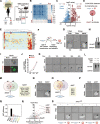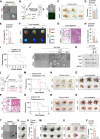Reprogramming anchorage dependency by adherent-to-suspension transition promotes metastatic dissemination
- PMID: 36991428
- PMCID: PMC10061822
- DOI: 10.1186/s12943-023-01753-7
Reprogramming anchorage dependency by adherent-to-suspension transition promotes metastatic dissemination
Erratum in
-
Correction: Reprogramming anchorage dependency by adherent‑to‑suspension transition promotes metastatic dissemination.Mol Cancer. 2023 Aug 14;22(1):135. doi: 10.1186/s12943-023-01838-3. Mol Cancer. 2023. PMID: 37580748 Free PMC article. No abstract available.
Abstract
Background: Although metastasis is the foremost cause of cancer-related death, a specialized mechanism that reprograms anchorage dependency of solid tumor cells into circulating tumor cells (CTCs) during metastatic dissemination remains a critical area of challenge.
Methods: We analyzed blood cell-specific transcripts and selected key Adherent-to-Suspension Transition (AST) factors that are competent to reprogram anchorage dependency of adherent cells into suspension cells in an inducible and reversible manner. The mechanisms of AST were evaluated by a series of in vitro and in vivo assays. Paired samples of primary tumors, CTCs, and metastatic tumors were collected from breast cancer and melanoma mouse xenograft models and patients with de novo metastasis. Analyses of single-cell RNA sequencing (scRNA-seq) and tissue staining were performed to validate the role of AST factors in CTCs. Loss-of-function experiments were performed by shRNA knockdown, gene editing, and pharmacological inhibition to block metastasis and prolong survival.
Results: We discovered a biological phenomenon referred to as AST that reprograms adherent cells into suspension cells via defined hematopoietic transcriptional regulators, which are hijacked by solid tumor cells to disseminate into CTCs. Induction of AST in adherent cells 1) suppress global integrin/ECM gene expression via Hippo-YAP/TEAD inhibition to evoke spontaneous cell-matrix dissociation and 2) upregulate globin genes that prevent oxidative stress to acquire anoikis resistance, in the absence of lineage differentiation. During dissemination, we uncover the critical roles of AST factors in CTCs derived from patients with de novo metastasis and mouse models. Pharmacological blockade of AST factors via thalidomide derivatives in breast cancer and melanoma cells abrogated CTC formation and suppressed lung metastases without affecting the primary tumor growth.
Conclusion: We demonstrate that suspension cells can directly arise from adherent cells by the addition of defined hematopoietic factors that confer metastatic traits. Furthermore, our findings expand the prevailing cancer treatment paradigm toward direct intervention within the metastatic spread of cancer.
© 2023. The Author(s).
Conflict of interest statement
The authors declare that they have no conflict of interests.
Figures





References
Publication types
MeSH terms
LinkOut - more resources
Full Text Sources
Medical
Research Materials

